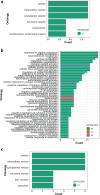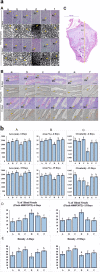Transcriptome-based biomarker gene screening and evaluation of the extracellular fatty acid-binding protein (Ex-FABP) on immune and angiogenesis-related genes in chicken erythrocytes of tibial dyschondroplasia
- PMID: 35459093
- PMCID: PMC9034513
- DOI: 10.1186/s12864-022-08494-9
Transcriptome-based biomarker gene screening and evaluation of the extracellular fatty acid-binding protein (Ex-FABP) on immune and angiogenesis-related genes in chicken erythrocytes of tibial dyschondroplasia
Abstract
Background: Tibial dyschondroplasia (TD) is a bone disorder in which dead chondrocytes accumulate as a result of apoptosis and non-vascularization in the tibial bone of broiler chickens. The pathogenicity of TD is under extensive research but is yet not fully understood. Several studies have linked it to apoptosis and non-vascularization in the tibial growth plate (GP). We conceived the idea to find the differentially expressed genes (DEGs) in chicken erythrocytes which vary in expression over time using a likelihood-ratio test (LRT). Thiram was used to induce TD in chickens, and then injected Ex-FABP protein at 0, 20, and 50 μg.kg-1 to evaluate its therapeutic effect on 30 screened immunity and angiogenesis-related genes using quantitative PCR (qPCR). The histopathology was also performed in TD chickens to explore the shape, circularity, arrangements of chondrocytes and blood vessels.
Results: Clinical lameness was observed in TD chickens, which decreased with the injection of Ex-FABP. Histopathological findings support Ex-FABP as a therapeutic agent for the morphology and vascularization of affected chondrocytes in TD chickens. qPCR results of 10 immunity (TLR2, TLR3, TLR4, TLR5, TLR7, TLR15, IL-7, MyD88, MHCII, and TRAF6) and 20 angiogenesis-related genes (ITGAV, ITGA2, ITGB2, ITGB3, ITGA5, IL1R1, TBXA2R, RPL17, F13A1, CLU, RAC2, RAP1B, GIT1, FYN, IQGAP2, PTCH1, NCOR2, VAV-like, PTPN11, MAML3) regulated when Ex-FABP is injected to TD chickens.
Conclusion: Immunity and angiogenesis-related genes can be responsible for apoptosis of chondrocytes and vascularization in tibial GP. Injection of Ex-FABP protein to thiram induced TD chickens decrease the chondrocytes damage and improves vascularization.
Keywords: Angiogenesis; Biomarker-genes; Bone-deformity; Broiler; Ex-FABP; Immunity.
© 2022. The Author(s).
Conflict of interest statement
The authors declare that they have no competing interests.
Figures







Similar articles
-
Transcriptome-based screening of intracellular pathways and angiogenesis related genes at different stages of thiram induced tibial lesions in broiler chickens.BMC Genomics. 2020 Jan 15;21(1):50. doi: 10.1186/s12864-020-6456-9. BMC Genomics. 2020. PMID: 31941444 Free PMC article.
-
Recombinant glutathione-S-transferase A3 protein regulates the angiogenesis-related genes of erythrocytes in thiram induced tibial lesions.Res Vet Sci. 2020 Aug;131:244-253. doi: 10.1016/j.rvsc.2020.05.007. Epub 2020 May 11. Res Vet Sci. 2020. PMID: 32438067
-
Transcriptome analysis of MAPK signaling pathway and associated genes to angiogenesis in chicken erythrocytes on response to thiram-induced tibial lesions.Res Vet Sci. 2019 Dec;127:65-75. doi: 10.1016/j.rvsc.2019.10.013. Epub 2019 Oct 31. Res Vet Sci. 2019. PMID: 31678455
-
Cellular, molecular and genetical overview of avian tibial dyschondroplasia.Res Vet Sci. 2021 Mar;135:569-579. doi: 10.1016/j.rvsc.2020.10.002. Epub 2020 Oct 8. Res Vet Sci. 2021. PMID: 33066991 Review.
-
The role of blood vessels in broiler chickens with tibial dyschondroplasia.Poult Sci. 2019 Dec 1;98(12):6527-6532. doi: 10.3382/ps/pez497. Poult Sci. 2019. PMID: 31433842 Free PMC article. Review.
References
MeSH terms
Substances
LinkOut - more resources
Full Text Sources
Research Materials
Miscellaneous

